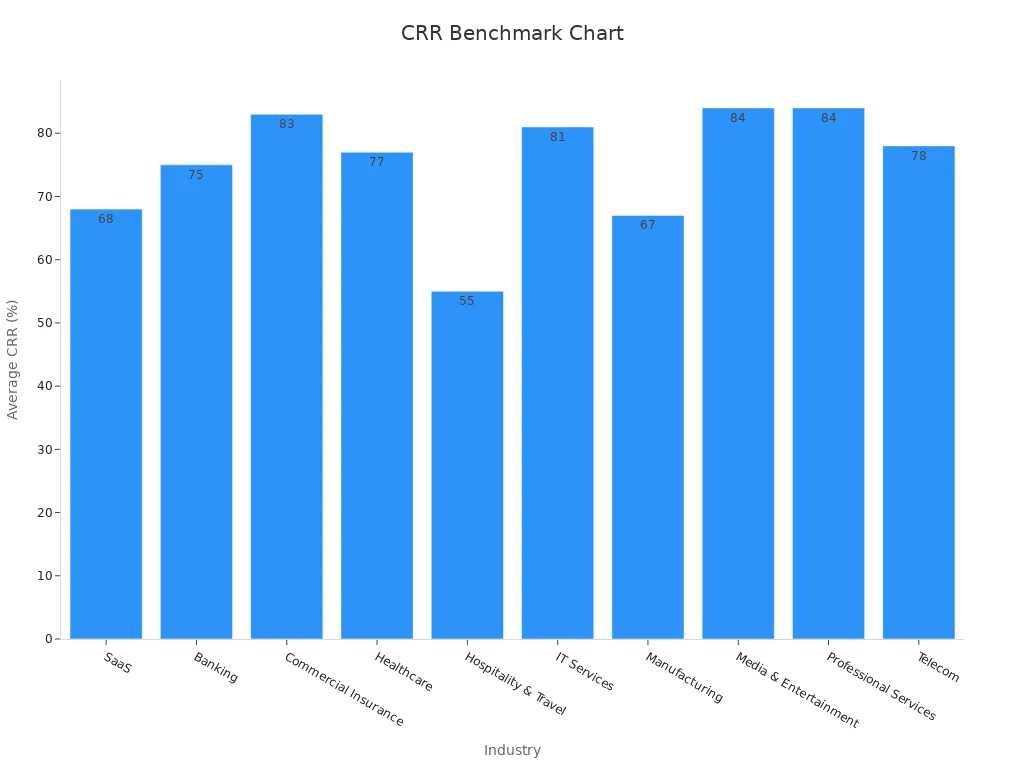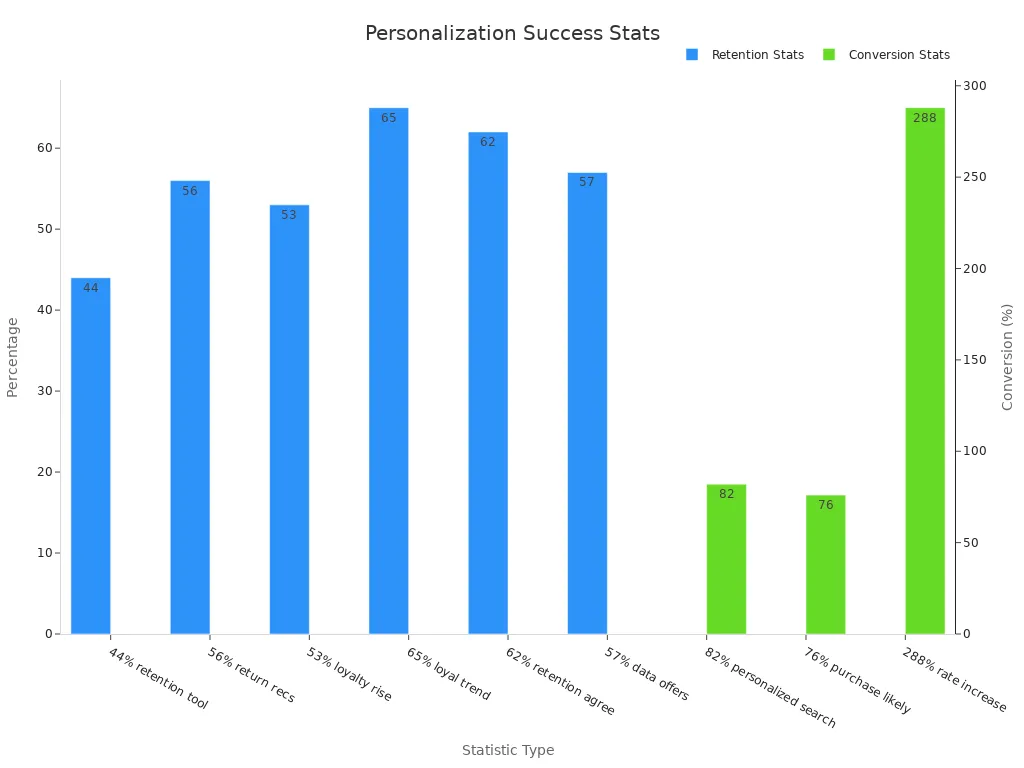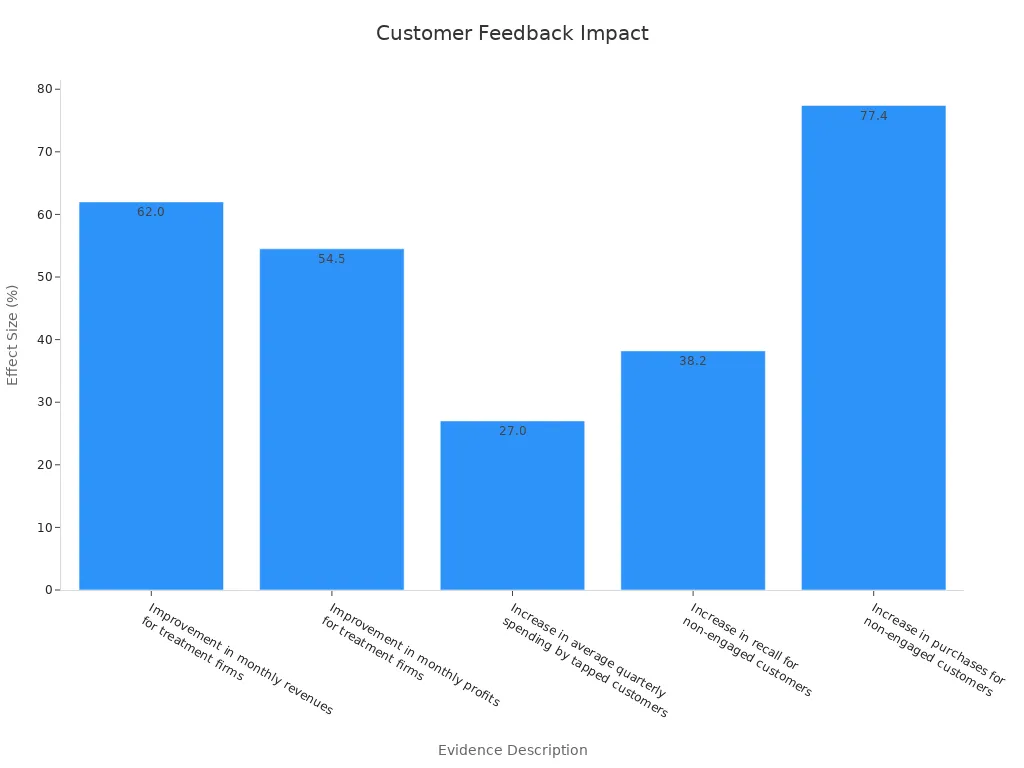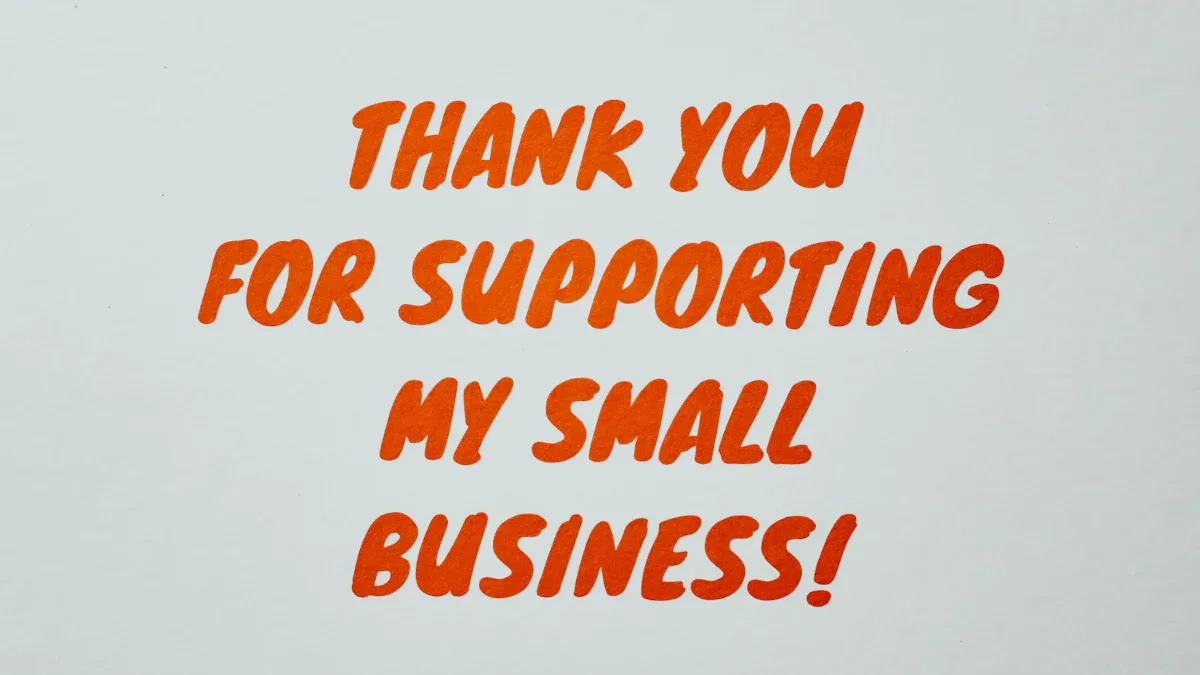10 Customer Retention Strategies Every Business Should Know

Customer retention is the backbone of sustainable business growth. When you keep customers coming back, you don’t just save money—you build loyalty that drives long-term success. Did you know retaining a customer costs 5 to 25 times less than acquiring a new one? Plus, existing customers tend to spend more over time, with positive experiences increasing their spending by up to 140%.
Retention strategies are also cost-effective. Instead of pouring resources into advertising or sales commissions, you can focus on improving customer retention through better service or loyalty programs. Tools like Sobot, which specialize in personalized customer support, can help you enhance customer retention by ensuring fast and tailored interactions. Small improvements make a big difference, especially when 80% of Americans are already part of loyalty programs.
Ultimately, happy customers stick around, spend more, and even refer others—giving you a reliable return on investment without breaking the bank.
What Is Customer Retention and Why Is It Important?
Definition of Customer Retention
Customer retention refers to your ability to keep customers coming back to your business over time. It’s not just about making a sale; it’s about building a relationship that encourages repeat purchases and loyalty. Think of it as the art of turning first-time buyers into lifelong supporters. By focusing on retention, you’re creating a foundation for sustainable growth. After all, loyal customers are the ones who stick with you, even when competitors try to lure them away.
Why Retention Is More Cost-effective Than Acquisition
Did you know it costs significantly less to retain a customer than to acquire a new one? Studies show that increasing customer retention by just 5% can boost profits by 25% to 95%. Loyal customers also tend to spend more—23% more, to be exact—than the average shopper. Plus, 82% of businesses agree that retention is far cheaper than acquisition. Instead of spending heavily on ads or promotions to attract new buyers, you can focus on improving customer retention through strategies like loyalty programs or personalized support. This approach not only saves money but also strengthens your connection with existing customers.
| Evidence Type | Description |
|---|---|
| Increased AOV | Loyal customers are 23% more likely to spend with you than the average customer. |
| Increased profits | Increasing customer retention by 5% can increase profits anywhere from 25% to 95%. |
| Lower cost compared to acquisition | 82% of companies state that customer retention is far cheaper than customer acquisition. |
The Role of Retention in Building Long-term Customer Relationships
Retention isn’t just about keeping customers—it’s about creating meaningful connections. When you focus on retention, you’re investing in relationships that pay off in the long run. For example, repeat customers spend 67% more than new ones, and they’re more likely to refer others to your business. This ripple effect can lead to sustainable growth and predictable revenue. Additionally, loyal customers often provide valuable feedback, helping you improve your products or services. By prioritizing retention, you’re not just growing your business—you’re building a community of advocates who believe in your brand.
| Evidence | Description |
|---|---|
| 5% increase in retention | Can boost profits by 25% to 95%. |
| Existing customers | Spend 67% more than new ones, increasing Customer Lifetime Value (CLV). |
| Repeat purchases | Over 90% of consumers buy from brands with excellent customer service. |
How to Measure Customer Retention Success
Measuring customer retention success is essential for understanding how well your strategies are working. By tracking the right metrics, you can identify areas for improvement and ensure your efforts are paying off.
Key Metrics for Measuring Retention
To gauge customer retention, you need to focus on specific key performance indicators (KPIs). These metrics provide insights into customer loyalty, satisfaction, and overall business health. Here’s a quick breakdown:
| KPI | Formula | Importance |
|---|---|---|
| Customer Retention Rate (CRR) | CRR = ((C1 - ΔC) / C0) x 100 | Reflects the percentage of customers retained over time, showing loyalty levels. |
| Monthly Recurring Revenue (MRR) | MRR = Number of customers x Average revenue per customer | Tracks predictable revenue, highlighting retention through steady income. |
| Customer Lifetime Value (CLV) | CLV = Average Purchase Value x Average Purchase Frequency x Average Customer Lifespan | Helps assess the long-term value of customers, guiding retention strategies. |
| Net Promoter Score (NPS) | NPS = % of Promoters - % of Detractors | Measures customer loyalty and predicts retention through referrals. |
| Revenue Churn Rate | Revenue Churn Rate = (MRR at start - MRR at end) / MRR at start | Identifies revenue loss due to churn, helping you address retention issues. |
These KPIs are the foundation of improving customer retention. For example, tracking CRR helps you understand how many customers stay loyal, while CLV reveals the financial impact of those relationships.
Understanding Customer Retention Rate (CRR)
Customer Retention Rate (CRR) is one of the most reliable metrics for measuring loyalty. It calculates the percentage of customers who continue to do business with you over a specific period. For instance, if you started the month with 1,000 customers, lost 50, and gained 100, your CRR would be 95%. A high CRR indicates strong customer loyalty and satisfaction.
Different industries have varying benchmarks for CRR. For example, the media and entertainment sector boasts an average CRR of 84%, while hospitality and travel hover around 55%. Understanding these benchmarks can help you set realistic goals for your business.

Using Customer Lifetime Value (CLV) to Assess Retention
Customer Lifetime Value (CLV) is a powerful metric that quantifies the total revenue a customer generates during their relationship with your business. It’s a great way to measure the effectiveness of your retention strategies. For example, Amazon uses its Prime membership to boost CLV, with Prime members spending $1,340 annually compared to non-members.
By focusing on CLV, you can identify high-value customers and tailor your retention efforts to keep them engaged. Tools like Sobot can help you analyze customer data and create personalized experiences, ultimately increasing CLV and improving customer retention.
The Importance of Tracking Churn Rate
Churn rate is one of the most critical metrics for understanding how well your business retains customers. It measures the percentage of customers who stop doing business with you over a specific period. By tracking churn, you can identify patterns, spot potential issues, and take action to improve customer success. After all, if you don’t know why customers leave, how can you keep them?
Different industries experience varying churn rates. For example, SaaS companies typically see a monthly churn rate of 5–10%, while retail businesses face annual rates as high as 37%. Here’s a quick look at average churn rates across industries:
| Industry | Average Churn Rate |
|---|---|
| SaaS | 5–10% monthly |
| Telecom | 15–25% annually |
| Retail | 20–37% annually |
| Banking | 20% annually |
| Wholesale | 56% |
| Insurance | <5% |
| Utilities | <5% |
High churn rates can signal deeper problems, like poor customer service or unmet expectations. For instance, if your telecom company has a churn rate of 25%, it might indicate dissatisfaction with pricing or service quality. On the other hand, industries like insurance and utilities maintain low churn rates by focusing on customer success and long-term value.
To reduce churn, you need to act proactively. Tools like Sobot can help by offering personalized support and tracking customer interactions. This ensures you address issues before they escalate. Remember, happy customers are less likely to leave, and tracking churn gives you the insights needed to keep them satisfied.
Strategy 1: Enhance Customer Retention Through Exceptional Service
The Impact of Fast and Personalized Support
Fast and personalized support can make or break your customer relationships. When customers feel valued and heard, they’re more likely to stick around. Imagine reaching out for help and getting a quick, tailored response—wouldn’t that leave a lasting impression? Research backs this up. Customer satisfaction directly influences their decision to return, showing a clear link between exceptional service and retention rates.
| Evidence Type | Findings | Source |
|---|---|---|
| Customer Satisfaction Impact | Customer satisfaction significantly influences revisit intention among users, boosting retention. | Chi (2018) |
| Service Quality Dimensions | Enhancing reliability, trust, and personalization improves service quality and satisfaction. | Lee et al., 2018 |
| Mediation Analysis | Satisfaction mediates the relationship between service quality and revisit intention. | Heinonen, 2020 |
Using tools like Sobot can help you deliver this level of service. Sobot’s AI-driven customer support solutions ensure fast responses and personalized interactions, making it easier to enhance customer retention. By anticipating customer needs and addressing them quickly, you show that you care about their experience.
Examples of Outstanding Customer Service Practices
Some companies have mastered the art of exceptional service, and their success stories can inspire your approach. For instance:
- Zappos is famous for sending surprise gifts to customers, creating memorable experiences that foster loyalty.
- Adobe offers up to two months of free subscription to customers considering cancellation, showing a proactive effort to retain them.
- HubSpot’s research reveals that 96% of customers would continue buying from a company after receiving a sincere apology for a mistake.
These examples highlight how small gestures can enhance customer retention. Whether it’s a thoughtful gift, a proactive offer, or a heartfelt apology, these actions show customers they matter. You can adopt similar practices to build trust and loyalty. Tools like Sobot can help you track customer interactions and identify opportunities to go the extra mile.
Strategy 2: Build Effective Customer Retention Strategies with Loyalty Programs

Loyalty programs are one of the most effective customer retention strategies you can implement. They reward your customers for sticking with your brand, encouraging repeat purchases and fostering long-term relationships. When done right, loyalty programs can transform occasional shoppers into loyal advocates.
Types of Loyalty Programs (Points, Tiers, Discounts)
Not all loyalty programs are created equal. You’ll find several types, each catering to different customer preferences:
- Points-Based Programs: These are the most common. Customers earn points for every purchase, which they can redeem for rewards like discounts or free products. Studies show that customers who redeem points spend 2.5 times more than non-members.
- Tiered Programs: These programs offer increasing benefits as customers move up tiers based on their spending. For example, a bronze-tier customer might get free shipping, while a gold-tier customer enjoys exclusive discounts. Tiered programs deliver 1.8x higher ROI compared to programs without tiers.
- Discount Programs: These provide instant gratification, offering discounts or cashback on purchases. They’re great for boosting basket sizes, with data showing a 36% increase in average order value when discounts are applied.
Each type has its strengths, so choosing the right one depends on your audience. Tools like Sobot can help you analyze customer behavior and design a loyalty program that resonates with your customers.
How Loyalty Programs Drive Repeat Purchases
Loyalty programs don’t just reward customers—they drive behavior. Here’s how they encourage repeat purchases:
- Customers who opt into instant rewards, like cashback, increase their spending by 68% within two weeks.
- Saving up for larger rewards motivates customers to spend more over time, creating a cycle of engagement.
- Lower-spending customers often show the strongest increase in purchase behavior, proving that loyalty programs can convert casual shoppers into regular buyers.
Metrics like retention rate, churn rate, and redemption rate highlight the effectiveness of loyalty programs. For instance, a high redemption rate shows that customers value the rewards, while a low churn rate indicates strong customer loyalty.
| Metric | Description |
|---|---|
| Retention Rate | Measures the percentage of customers who continue to engage with a brand over time. |
| Customer Churn Rate | Indicates the percentage of customers who discontinue their relationship with a brand. |
| Engagement Metrics | Tracks customer interactions and participation in the loyalty program. |
| Redemption Rate | Reflects the percentage of customers redeeming rewards, showing how much they value the program. |
| Segmentation Analysis | Helps tailor the loyalty program to different customer segments, improving satisfaction and retention. |
| Referral Metrics | Measures the effectiveness of the program in attracting new customers through referrals. |
By leveraging these insights, you can refine your loyalty program to maximize its impact. Platforms like Sobot can help you track these metrics and optimize your program for better results.
Strategy 3: Personalize the Customer Experience
Personalization is the secret sauce for creating memorable customer experiences. When you tailor interactions to meet individual needs, you show customers that you value them. This approach doesn’t just improve satisfaction—it boosts customer retention and builds loyalty.
Leveraging Customer Data for Tailored Interactions
Customer data is the foundation of personalized experiences. By analyzing behavior, preferences, and purchase history, you can craft interactions that feel custom-made. For example, sending product recommendations based on past purchases or offering discounts on items customers frequently browse can make them feel understood.
Metrics validate the effectiveness of personalization strategies. Here’s a quick look:
| Metric Type | Description |
|---|---|
| Key Performance Indicators (KPIs) | Metrics such as conversion rates, segment engagement, and customer retention. |
| Attribution Models | Models to determine which personalization elements drive desired actions. |
| Engagement Metrics | Metrics like time on site, repeat visits, and click patterns for content effectiveness. |
| Brand Lift Surveys | Tools to assess shifts in awareness or sentiment post-campaign. |
Using tools like Sobot, you can leverage customer data to create tailored interactions. Sobot’s AI-driven solutions analyze customer behavior and automate personalized responses, ensuring every interaction feels unique. This not only enhances the customer experience but also strengthens loyalty.
Examples of Personalization in E-commerce and Service Industries
Personalization isn’t just a buzzword—it’s a proven strategy. In e-commerce, personalized product recommendations increase conversion rates by 288%. Imagine browsing an online store and seeing suggestions that match your style. That’s the power of personalization.
Service industries also benefit. For instance, 65% of consumers stay loyal to companies that offer personalized experiences. Hotels that remember guest preferences, like room type or favorite amenities, create a sense of belonging. Similarly, restaurants that tailor menus based on dietary restrictions make customers feel valued.
Here’s a snapshot of personalization success across industries:
| Statistic | Source |
|---|---|
| 44% of retailers identified website personalization tools as a primary tool for customer retention. | Mastercard |
| 56% of online customers are more likely to return to a site that offers product recommendations. | Invesp |
| 65% of consumers are more likely to stay loyal when a company offers a personalized experience. | Salesforce |
| Personalized product recommendations increase conversion rates by 288%. | N/A |

By implementing personalization strategies, you can transform customer interactions into meaningful connections. Platforms like Sobot make this easier by automating tailored responses and tracking engagement metrics.
Strategy 4: Communicate Regularly to Enhance Customer Retention
Staying connected with your customers is one of the simplest ways to boost customer retention. Regular communication keeps your brand top-of-mind and builds trust over time. Whether it’s through email or social media, consistent engagement shows your customers that you care about their experience.
The Role of Email Marketing and Newsletters
Email marketing is a powerful tool for customer engagement. It allows you to deliver personalized messages directly to your customers’ inboxes, keeping them informed and connected. Welcome emails, for instance, introduce new subscribers to your brand while inviting them to follow you on social media. Transactional emails, like order confirmations or shipping updates, reinforce your brand’s reliability.
Newsletters are equally effective. They let you share updates, offer exclusive deals, and even demonstrate your expertise. For example, a monthly newsletter could include tips related to your products or services, positioning your business as a trusted authority. Studies show that increasing customer retention by just 5% can lead to a 25% increase in profitability. This highlights how effective email marketing can be in driving repeat business.
To make the most of email campaigns, tools like Sobot can help. Sobot’s AI-driven solutions allow you to personalize communication, ensuring every email feels relevant and timely. Whether you’re launching a loyalty program or running a re-engagement campaign, Sobot simplifies the process and helps you track results.
Engaging Customers Through Social Media
Social media is another essential channel for customer retention. Platforms like Instagram, Facebook, and Twitter let you interact with customers in real-time, creating a sense of community. Responding to comments, sharing user-generated content, and hosting live Q&A sessions are great ways to keep customers engaged.
The impact of social media on customer retention is measurable. Metrics like Net Promoter Score (NPS) reveal how likely customers are to recommend your brand. Social commerce metrics, such as returning visitors and buyers, show how well your social media efforts drive repeat business. Tracking reviews also helps you understand customer satisfaction, with thoughtful responses boosting loyalty.
| Metric | Description |
|---|---|
| Net Promoter Score (NPS) | Measures customer loyalty by asking how likely they are to recommend the brand on a scale of 0-10. |
| Social Commerce Metrics | Tracks returning visitors and buyers from social platforms to gauge retention. |
| Reviews | Helps assess customer satisfaction and loyalty, with responses influencing retention. |
Using tools like Sobot, you can streamline social media interactions. Sobot’s platform enables you to manage customer inquiries across multiple channels, ensuring quick and personalized responses. This proactive approach strengthens customer engagement and reduces churn.
Strategy 5: Actively Seek and Act on Customer Feedback
Customer feedback is a goldmine for improving customer retention. When you actively listen to your customers, you show them that their opinions matter. This builds trust and strengthens your relationship with them. Plus, acting on feedback helps you refine your offerings and create a better customer experience.
Tools for Collecting Feedback (Surveys, Reviews)
Collecting feedback doesn’t have to be complicated. Tools like surveys and reviews make it easy to gather insights directly from your customers. Surveys are great for asking specific questions about their experience. For example, you can use tools like Google Forms or Typeform to create quick surveys that customers can complete in minutes. Reviews, on the other hand, provide unfiltered opinions. Platforms like Yelp or Trustpilot allow customers to share their thoughts, giving you a clear picture of what’s working and what’s not.
The impact of collecting feedback is significant. Businesses that actively seek feedback see a 62% improvement in monthly revenues and a 54.5% boost in profits. Customers who feel heard are also more likely to stay engaged, with non-engaged customers increasing their purchases by 77.4% after being tapped for feedback.

Turning Feedback into Actionable Improvements
Gathering feedback is just the first step. The real magic happens when you act on it. Start by analyzing the data to identify trends and areas for improvement. For instance, if customers frequently mention slow response times, you can invest in tools like Sobot to streamline your customer support. Sobot’s AI-driven solutions help you respond faster and more effectively, enhancing customer engagement.
Here’s how businesses have turned feedback into measurable results:
| Strategy | Action Taken | Measurable Result |
|---|---|---|
| Targeted Surveys | Designed specific questions to gather relevant feedback | Improved response rates by 30% |
| Regular Feedback Analysis | Identified trends and areas for improvement | Increased customer satisfaction by 25% |
| Implementing Changes | Acted on customer insights to enhance experience | Boosted customer loyalty by 40% |
By acting on feedback, you’re not just improving customer retention—you’re creating a cycle of continuous improvement. Customers notice when their input leads to real changes, and this strengthens their loyalty to your brand.
Strategy 6: Offer Proactive Support to Retain Customers
Anticipating Customer Needs Before They Arise
Proactive support is all about staying one step ahead. Instead of waiting for customers to reach out with problems, you anticipate their needs and address issues before they even arise. This approach shows customers that you genuinely care about their experience, which strengthens loyalty and improves customer retention.
For example, tracking user behavior can help you identify at-risk customers. If you notice someone abandoning a checkout process or struggling with a feature, you can step in to assist. Tools like Pendo Analytics and Session Replay make this easier by providing insights into user activity and highlighting areas that need improvement.
Proactive service signifies a shift in customer support, where agents anticipate and address customer needs before they arise. This approach not only enhances customer experience but also leads to operational efficiencies by reducing handle times and minimizing repeat contacts. Furthermore, it fosters stronger customer relationships, resulting in increased retention rates and higher customer lifetime value.
Platforms like Sobot can help you implement proactive support seamlessly. Sobot’s AI-driven tools analyze customer interactions and predict potential issues, allowing you to offer solutions before customers even ask. This not only boosts customer engagement but also reduces churn.
Examples of Proactive Support in Call Centers and E-commerce
Proactive support isn’t limited to one industry. In call centers, it can reduce service costs and call volumes significantly. For instance, AI-powered solutions are expected to save businesses $11 billion annually by 2025. They also cut call volumes by 20–30% and reduce service costs by up to 25%.
| Metric | Value |
|---|---|
| Expected annual savings by AI | $11 billion by 2025 |
| Reduction in call volumes | 20–30% |
| Reduction in service costs | Up to 25% |
In e-commerce, proactive support can prevent cart abandonment and improve customer retention. Imagine receiving a helpful email when you leave items in your cart or getting a quick response about a product you’re browsing. These small actions make a big difference. Sobot’s tools can help you automate these interactions, ensuring customers feel supported at every step of their journey.
By anticipating needs and offering proactive solutions, you create a seamless customer experience that keeps people coming back. This strategy is key to improving customer retention and building lasting relationships.
Strategy 7: Create a Seamless Onboarding Process

The Importance of First Impressions in Retention
First impressions matter, especially when it comes to onboarding. A smooth and welcoming onboarding process sets the tone for your customer’s entire journey with your business. Did you know that 80% of customers abandon a product or service within the first 90 days if their onboarding experience falls short? That’s a huge number, but it highlights how critical this stage is for customer retention.
When onboarding is done right, customers are 86% more likely to stick around and renew their subscriptions. It’s not just about showing them how to use your product—it’s about helping them see its value quickly. The faster they experience success, the more likely they are to stay loyal. Metrics like retention rate, engagement rate, and time to value can help you measure how effective your onboarding process is. For example:
| Metric | Description |
|---|---|
| Retention Rate | The percentage of users retained over time, crucial for assessing onboarding effectiveness. |
| Engagement Rate | The percentage of users actively using the product, indicating how well onboarding fosters usage. |
| Completion Rate | The percentage of users finishing the onboarding process, essential for conversion rates. |
| Time to Value | The duration it takes for users to realize the product's value, impacting first impressions. |
| Activation Rate | The percentage of users reaching key activation points, linked to long-term retention. |
By focusing on these metrics, you can ensure your onboarding process leaves a lasting positive impression.
Steps to Simplify and Enhance Onboarding
Simplifying your onboarding process doesn’t have to be complicated. Start by breaking it into clear, actionable steps. Here are some proven ways to make onboarding more effective:
- Personalized Communication: Tailor your messages to each customer. For instance, send a welcome email that highlights features they’ll find most useful.
- Proactive Support: Don’t wait for customers to ask for help. Offer guidance before they encounter issues. Tools like Sobot can help you track user behavior and provide timely assistance.
- Continuous Feedback Collection: Regularly ask for feedback to identify pain points in your onboarding process. This shows customers you care about their experience.
- Use of Analytics: Track key metrics like completion rates and activation points. These insights help you refine your onboarding flow.
For example, if you notice a drop-off during a specific step, you can adjust that part to make it more user-friendly. Businesses that focus on improving onboarding often see a 5% increase in customer retention, which can lead to a 25%-95% boost in profits. That’s a win-win for both you and your customers.
Strategy 8: Reward Referrals and Advocacy
Referral programs are a win-win for both you and your customers. They encourage your existing customers to spread the word about your business while rewarding them for their loyalty. This strategy not only boosts customer retention but also helps you attract new customers who are more likely to stick around.
Benefits of Referral Programs for Retention
Referral programs are one of the most effective customer retention strategies. Why? Because customers trust recommendations from people they know. When someone refers your business to a friend, that new customer is already primed to trust you. In fact:
- Customers referred by others have a 37% higher retention rate.
- Referred employees, for example, tend to stay longer than those hired through other channels.
Here’s a quick comparison of retention rates across different referral sources:
| Source | Retention Rate |
|---|---|
| Employee referral program | 42% |
| Job boards | 32% |
| Career sites | 14% |
These numbers show how referrals create stronger, longer-lasting relationships. By rewarding your customers for referrals, you’re not just gaining new business—you’re building a loyal community.
Encouraging Customers to Become Brand Advocates
Turning your customers into advocates takes your referral program to the next level. Advocates don’t just refer others; they actively promote your brand because they believe in it. This kind of advocacy has measurable benefits:
| Benefit Area | Impact Metrics |
|---|---|
| Sales Acceleration | Referral-based leads convert 4x faster with 30% higher average value |
| Marketing Efficiency | Advocates generate content at 1/10th the cost of traditional creation |
| Product Development | Advocate feedback reduces development cycles by up to 20% |
| Customer Support | Community-based support reduces ticket volume by 10-25% |
To encourage advocacy, make it easy for customers to share their experiences. Offer incentives like discounts, loyalty program points, or exclusive perks. Tools like Sobot can help you track referrals and automate rewards, ensuring a seamless experience for your advocates. When customers feel appreciated, they’re more likely to stay loyal and keep spreading the word.
Strategy 9: Consistently Deliver Value to Enhance Customer Retention
Ensuring Product/Service Quality Meets Expectations
Delivering consistent quality is one of the most effective ways to keep your customers coming back. When your product or service meets—or even exceeds—expectations, it builds trust and loyalty. Think about it: would you return to a restaurant that served you a cold meal? Probably not. The same principle applies to any business. Customers expect reliability, and when you deliver, they reward you with their loyalty.
Quality assurance (QA) plays a huge role here. Businesses that invest in QA processes see significant improvements in customer satisfaction and service quality. Take a look at these stats:
| Statistic | Percentage |
|---|---|
| Organizations agreeing QA processes improve customer service quality | 86% |
| Organizations agreeing QA helps improve customer satisfaction (CSAT) | 76% |
These numbers show how much of an impact quality has on customer retention. Tools like Sobot can help you maintain high standards by streamlining your operations and ensuring consistent service delivery. For example, Sobot’s AI-driven solutions can monitor customer interactions, helping you identify and resolve issues before they escalate. This proactive approach enhances the overall customer experience and keeps your audience engaged.
Adding Value Through Educational Content or Resources
Sometimes, delivering value goes beyond the product itself. Offering educational content or resources can make a big difference in how customers perceive your brand. Imagine buying a new gadget and receiving a series of easy-to-follow tutorials on how to use it. That extra effort not only makes your life easier but also strengthens your connection to the brand.
Educational content has a measurable impact on retention. Recent studies reveal:
| Statistic | Impact on Retention |
|---|---|
| Average increase in product retention | 22% |
| Percentage of companies seeing improved retention | 56% |
This approach works because it empowers your customers. When they feel confident using your product or service, they’re more likely to stick around. You can create how-to guides, video tutorials, or even host webinars to share valuable insights. For instance, Sobot offers resources that help businesses optimize their customer support strategies. These tools not only improve customer retention but also position your brand as a trusted expert in your field.
By consistently delivering value—whether through quality or education—you show your customers that you’re invested in their success. And when customers feel valued, they’re far less likely to leave.
Strategy 10: Build Emotional Connections with Customers
Building emotional connections with your customers is one of the most powerful customer retention strategies. When customers feel emotionally invested in your brand, they’re more likely to stay loyal and recommend your business to others.
The Role of Brand Storytelling in Retention
Storytelling is a tool that helps you connect with your customers on a deeper level. It’s not just about selling a product; it’s about sharing a narrative that resonates with their values and aspirations. When your brand tells a compelling story, it creates an emotional bond that fosters customer loyalty.
For example, Nike’s "Just Do It" slogan inspires athletes by sharing stories of perseverance and triumph. These narratives make customers feel like they’re part of a community that values hard work and determination. Similarly, Dove’s "Real Beauty" campaign promotes self-acceptance and diversity. By showcasing real people and their stories, Dove builds trust and emotional connections with its audience.
You can use storytelling to highlight your brand’s mission, values, or even customer success stories. Platforms like Sobot can help you collect customer feedback and identify stories that resonate with your audience. Sharing these stories through social media, email campaigns, or your website can strengthen your emotional connection with customers.
Examples of Brands That Foster Emotional Loyalty
Some brands excel at creating emotional loyalty through storytelling. Here are two standout examples:
- Nike: Their "Just Do It" campaign doesn’t just sell shoes; it sells a mindset. By featuring athletes overcoming challenges, Nike inspires customers to push their limits and achieve their goals.
- Dove: The "Real Beauty" campaign celebrates individuality and self-confidence. By focusing on real people instead of models, Dove creates a sense of authenticity that resonates with its audience.
These brands show how storytelling can transform customer relationships. When you focus on emotions, you create a lasting impression that keeps customers coming back. Tools like Sobot can help you analyze customer interactions and identify opportunities to build emotional connections. By leveraging these insights, you can craft stories that align with your customers’ values and enhance retention.
Customer retention is the cornerstone of sustainable business growth. When you focus on keeping your customers happy, you unlock predictable revenue, deeper loyalty, and long-term success. Retention strategies like personalized experiences, loyalty programs, and proactive support don’t just reduce churn—they create lasting relationships that drive repeat business.
Here’s why these strategies work:
- Retained customers spend more over time, boosting your bottom line.
- Strong retention efforts foster loyalty, making customers more likely to recommend your brand.
- Metrics like Customer Retention Rate and Net Revenue Retention show measurable improvements when you prioritize retention.
| Metric | Description |
|---|---|
| Customer Retention Rate | Measures the percentage of customers a business retains over a specific period. |
| Net Revenue Retention (NRR) | Indicates the percentage of recurring revenue retained from existing customers, accounting for upgrades, downgrades, and cancellations. |
| Customer Lifetime Value (CLV) | Estimates the total revenue expected from a customer throughout the relationship. |
| Net Promoter Score (NPS) | Assesses customer satisfaction and loyalty based on their likelihood to recommend the product. |
By implementing these customer retention strategies, you’ll not only save on acquisition costs but also build a loyal customer base that grows with your business. Start small—whether it’s improving onboarding or launching a loyalty program—and watch the results unfold.
FAQ
What is the best way to measure customer retention?
Tracking metrics like Customer Retention Rate (CRR) and Customer Lifetime Value (CLV) gives you a clear picture of loyalty. Tools like Sobot help you monitor these metrics and analyze customer behavior. This makes it easier to spot trends and improve retention strategies.
How can loyalty programs improve customer retention?
Loyalty programs reward repeat purchases, making customers feel valued. For example, points-based systems encourage spending by offering redeemable rewards. Sobot’s analytics tools can help you design programs tailored to your audience, ensuring they stay engaged and keep coming back.
Why is personalization important for customer retention?
Personalization shows customers you understand their needs. Tailored recommendations or customized emails create memorable experiences. Sobot’s AI-driven solutions analyze customer data to deliver personalized interactions, boosting satisfaction and loyalty. Studies show personalized experiences increase retention by up to 65%.
How does proactive support reduce churn?
Proactive support anticipates customer needs before problems arise. For instance, sending helpful tips or reminders prevents frustration. Sobot’s AI tools track user behavior and automate proactive outreach, ensuring customers feel supported and valued. This approach reduces churn and strengthens relationships.
Can customer feedback improve retention strategies?
Absolutely! Feedback highlights areas for improvement. Surveys and reviews help you understand customer expectations. Acting on feedback builds trust and loyalty. Sobot’s tools simplify feedback collection and analysis, helping you turn insights into actionable changes that enhance retention.
See Also
10 Strategies to Enhance Live Chat Customer Experience
The 10 Leading Customer Service Tools for 2024
10 Premier Voice of Customer Solutions for 2024
